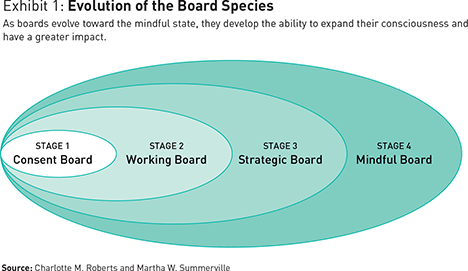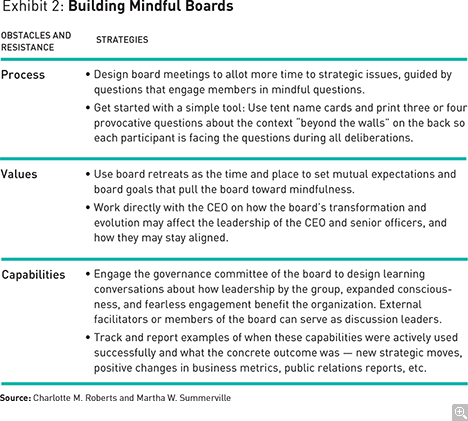The Mindful Board
Directors facing complex corporate governance challenges can develop their capacity to think together about the implications of their decisions.
In 1995, the board of directors of Methodist Hospital faced a profound decision over the institution’s future. The hospital, based in Indianapolis and owned by the Methodist Church, had significant financial assets, but its patient numbers were declining. It was considering a business relationship with both Riley Hospital for Children and University Hospital, two local academic facilities managed by and for the School of Medicine of Indiana University. As state-owned institutions, they lacked the funds and patient population to support their own three-part mission: education, research, and patient care. The church could have sold the hospital to a third party and invested the proceeds in church endeavors. But it recognized that the mission of the prospective joint entity was far more important. Equally important, the board decided that loading the new organization with debt (to fund the consolidation) would be detrimental to its long-term mission. For nearly two years, Methodist Hospital’s board deliberated and discussed the practical and moral nature of such a merger. Meetings, updates from the task force that was negotiating details, and intense conversations with the local bishop informed the board’s evolving understanding of the terms of the transaction, the changing external environment, and the future mission of the hospital. On January 1, 1997, the Methodist Hospital board voted unanimously to join the consolidated entity, Clarian Health Partners.
A second weighty decision arose a few years later. In 2003, Clarian Health Partners’ board members drew on their visceral memories of the merger decision when they considered a statewide growth strategy. Clarian’s “Three-Front Strategy” focused on maintaining a commitment to the downtown academic health center, emphasizing success and growth for the suburbs surrounding Indianapolis, and continuing to develop in certain other regions of the state. The board recognized the political nature of the expansion, which would simultaneously transform the institution and its governance structure while having significant impacts on other stakeholders. Building new locations would pose challenges to existing medical relationships, bring the hospital into competition with more providers in the state, and require more debt. After a year of examining and refining the model for growth, the board approved the transformative strategy.
In 2010, a third major decision was needed as the board reconsidered a complex challenge to change the organization’s name. Clarian Health Partners had been settled upon in 1997 as an “empty vessel”: the name symbolized its multifaceted origins, and its commitment to hold its consolidated entities without favoring any founding party. But as the organization grew and matured, the board realized that it would be more helpful to have a name that reflected its tripartite mission. And so the board changed the name to Indiana University Health in 2011. In 1997, the system had three primary locations, nearly 10,000 employees, and US$931 million in revenues; today, it has grown to 18 facilities, nearly 30,000 employees, and revenues exceeding $5 billion.
These three important decisions may strike some observers as typical corporate moves. But the way in which they were made was innovative and forward-looking, as is the way in which Indiana University Health’s board continues to conduct itself. Simply put, the board has learned how to make weighty decisions mindfully with a formal process.
Through that process, it strives to be aware of the broader contexts in which it operates. To begin each meeting, the board has a “connect to purpose” moment, such as a story from a patient or physician, or a video of a party for children at Riley Hospital. This moment is a way to remind those gathered of the spiritual side of healthcare and the organization’s effect on patients and their families. When confronted with a profound decision, one that will have wide impact on Indiana University Health’s three-part mission for generations to come, the board’s values and ethics committee convenes a group of citizens and members of the system for input before bringing a recommendation to the full board. The board is constantly looking at trends in providing healthcare to all citizens and envisioning their implications for Indiana University Health.
This organization typifies an emerging style of corporate governance: the mindful board.
The Evolution of Governance
A governing board develops new capabilities and expanded purpose only when internal and external pressures require it to do so. Life in the C-suite is getting more complicated; boardroom challenges, too, are becoming knotty enough to impel an evolution in governance.
People are seeking peaceful moments in a world fraught with intensity, stress, and complexity, which is why mindfulness has become so popular in corporations today. Meditation, yoga, and consciousness-raising programs are being rolled out in offices from Silicon Valley to Wall Street. Mindfulness is a tool that executives and board members can find useful in observing thoughts, feelings, and biases during group deliberations. Insights arising from such reflection can influence subsequent actions.
Mindful boards intentionally look out at the world through multiple windows — technology, politics, sociology, environment, and economics.
Our definition of the mindful board, however, goes far beyond personal mindfulness practices. Mindfulness in the boardroom refers to the capacity of a group of people to think in a deep way together. In assessing a current challenge, the mindful board looks to the past, present, and future. Deliberations encompass the impact of a decision not only on the enterprise, but on industry, society, and the planet. And the board considers how the decision will play out in both the short term and the very long term. Mindful boards intentionally look out at the world through multiple windows — technology, politics, sociology, environment, and economics. To leverage the power of using multiple windows, members of the mindful board hone their individual capabilities while practicing three interdependent disciplines as a governing body: leadership by the group, expanded consciousness, and fearless engagement.
Through our experiences as board members, board leaders, and consultants, we have uncovered a developmental path that boards can choose to move along as their internal and external contexts change (see Exhibit 1). That path consists of four stages, of which the first three are relatively common and the fourth, which represents the next wave, is rare. Mindful boards, compared with other boards, are highly capable of meeting the increasingly complex governance challenges faced by companies.
Consent board. The consent board is the traditional model of governance. Engagement is minimal, as members focus on fiduciary oversight responsibilities and supporting the agenda set by the CEO. At its best, the consent board is efficient and tightly managed. Open dissent is discouraged, and monitoring officers’ actions is regarded as poor form. The limitations of this stage are evident when poor governance spills out into public view — as happened with the Enron and WorldCom implosions in 2001 and the 2008 serial banking debacles.
Working board. Through its committee structure and in partnership with officers, the working board builds a greater understanding of operations and performance in key markets, and connects operational performance to competitive advantage. Although the board’s agenda remains driven primarily by the chief executive officer and the board chair, the members have an expanded view of operations and the business model. Yet that view does not increase the board’s likelihood of detecting broader issues and potential strategies that might move beyond senior management’s analysis.
Strategic board. The strategic board understands the organization’s wider reaches in its regional, national, and international contexts. It takes a longer-term view of the organization’s business success and potential impact on the community and society. It seeks wider and longer perspectives, sometimes by turning to outside expertise, and distinguishes itself through systems thinking — both seeing the interdependencies among the constituent parts and seeing the whole organization in the context of larger systems. But the strategic board is constrained by its focus on one industry or sector. When they are faced with a profound challenge, or when significant changes occur in society, technology, or economies outside the industry, the board members may fail to identify risks and opportunities. The strategic board looks out a variety of windows — all facing the same direction.
Broader Perspective
The mindful board represents the fourth stage, and is beginning to emerge as external pressures increase and the negative impact of unintended consequences expands. In the world of corporate governance, mindfulness can be seen in trends such as the rise of the benefit corporation, or B-corp (firms mandated by their charter to benefit both their owners and the greater good); examples include King Arthur Flour and Patagonia. The corporate social responsibility (CSR) movement and the prevalence of socially responsible investment strategies are part of boardroom conversations. “CSR isn’t just becoming part of the CEO and board agenda; it is the CEO and board agenda,” said Dave Stangis, vice president of public affairs and corporate sustainability for Campbell Soup Company.
As a board advances along the pathway, its purpose and capabilities transform. Members accumulate all the skills and capabilities from previous stages and expand the board’s capacity to govern in complex systems. The mindful board deliberates, discerns, and acts in a mindful way through critical decisions and episodes. Its purpose expands to include the well-being of the enterprise and those affected by the organization and its actions, and the fulfillment of the organization’s raison d’être. Members think beyond the walls of the organization in time (considering the past, present, and future aspects of a decision), space (looking at implications for the enterprise, industry, society, and planet), and intention (exploring whether the decision will achieve their goals in the short run, in the long run, and in perpetuity). They draw from a deep well of acquired capabilities — fiduciary oversight, operational leadership, context intelligence, systems thinking, and strategic thinking. Imagine looking through multiple windows — that offer views in multiple directions.
A board truly governs as mindful only when it consciously commits to the three interdependent disciplines mentioned earlier. The board gains its unique advantage from this trio: leadership by the group, expanded consciousness, and fearless engagement.
Leadership by the Group
Let’s consider how leadership by the group is manifested by looking at a hypothetical case: an enterprise wrestling with new data about significant negative consequences on human beings, communities, and the environment from its production facilities in multiple countries. If the company has a consent board, the CEO presents the issues with a proposed solution, and the board chair frames the question for time-bound deliberation. If it has a working board, a committee vets the issue before presenting it to the whole board. Individual directors are expected to ask questions, respectfully challenge assumptions, and bring their expertise into the deliberations, which are directed by the CEO or board chair. In a strategic board, the board wrestles with the issue while paying attention to the long- and short-term risks and benefits associated with the proposed response. Board members are expected to engage in the debate about next steps, keeping the organization’s best interests over the next decade always front and center.
A mindful board goes further. It creates the space for everyone in the room to fearlessly participate in deliberations and deep discernment. Any member can lead the conversation, and no one waits for an invitation to enter the dialogue. Everyone present is obligated to ensure that robust conclusions and decisions are made. Leadership by the group does not negate or devalue the importance of formal leadership roles and responsibilities; leaders frame and guide the work of the board. This group capability catalyzes insights that can make connections between forces outside the realm of the industry and the organization’s vision, strategy, and operations. Combining systems thinking and strategic thinking, board members can attend to the potential risks associated with a decision and the unintended consequences. Leadership by the group invites an outside-in perspective. In our hypothetical situation, group members raise questions about the organization’s responsibility to those impacted by the supply chain issues. They debate the best response for both the communities and the enterprise. Each member is accountable to the group and responsible for the quality of the group’s outcome.
Expanded Consciousness
Expanded consciousness describes the process of moving from looking out one small window to looking out a larger window, then moving to multiple windows with a 180-degree view to the edges of the horizon, and then finally moving to more windows with an elevated 360-degree view that extends farther. Expanded consciousness also requires the viewer to look inside himself or herself for biases and blind spots, and to strain to see what has been just out of sight in the environment.
A consent board depends on the CEO to provide the insights and expanded awareness that are relevant to the immediate goals. By contrast, a working board will develop its expanded consciousness to improve operational performance and its competitive advantage. A strategic board, for its part, will develop and utilize expanded consciousness to anticipate industry or sector changes and expand its view of potential products, services, and markets beyond its traditional scope.
Only the mindful board treats expanded consciousness as a necessary discipline in conducting its work. Individual board members and the board as a group expand their consciousness by continually learning about the business; the industry; the communities being served; and the global social, political, and economic trends. They proactively seek outside opinions and data to expand the view. Members challenge valued assumptions and beliefs and look to other organizations or cultures for insights. And they appreciate that complex systems require balancing responsibility for the organization with the transcendent social responsibility to those beyond the company’s walls. When board members and officers dedicate time to expanding their collective understanding, they find answers to critical strategic questions and open up potential new pathways.
Manifestations of such expanded consciousness can be seen in, for example, the recent decision by drugstore chain CVS to stop selling cigarettes — a $2 billion annual business. Considering changes in the external environment and attitudes toward smoking along with changes in its business strategy to focus more on prescription drugs and health products and services, the board came to realize that the sale of tobacco products was no longer compatible with its mission. “It is the right thing for us to do for our customers and our company to help people on their path to better health,” said Larry Merlo, chairman of the board at CVS. “Put simply, the sale of tobacco products is inconsistent with our purpose.”
Fearless Engagement
The most valuable board members have no qualms about discussing or exercising their capability to see an issue or situation through different lenses, and to draw attention to relevant connections and consequences. Fearless engagement can happen at any stage on the continuum. On a consent board, members take on risk if they challenge assumptions or offer an observation of how the problem is understood. On a working board, members will fearlessly engage in committee deliberations and be cautious in plenary sessions, following the lead of senior management on how to solve the problem. On a strategic board, fearless engagement may be encouraged in the interest of reducing the risks to enterprise health and sustainability, but board leaders may discourage people from going off on tangents.
In contrast, the mindful board will consistently practice fearless engagement to broaden and deepen the discussion. The board member brings all his or her intelligences (fiscal, social, political, emotional, noetic, economic, cultural) into deliberations in service to the board, to the organization, and to the communities it serves. When board members engage fearlessly in deliberations, they take advantage of the group’s diversity. Fearless engagement isn’t mayhem. It is based in honesty, respect, and trust. Directors seek out one another’s points of view and are willing to challenge opinions and assumptions without damaging relationships. Fearless engagement requires that people speak up about what is being ignored in the conversations. Doing so opens new windows through which the board can see. A mindful board member must recognize the delicate balance of when to stop talking, when to persist, and when to allow the issue to ripen. Fearless engagement carries an obligation for each member to move conversations toward insight and a sense of unity among the group.
Mastering Governance
When the board develops and employs the three governance disciplines in concert, it significantly improves the core business capabilities we associate with governance. These include fiduciary oversight, operational performance assessment, strategic thinking, and systems thinking. This is the primary distinction between the consent, working, and strategic boards, on one hand, and the mindful board, on the other. The latter leverages its ability to think beyond the walls of the organization in time, space, and intention. New insights emerge that lead to new ways of thinking about dilemmas or puzzles. As in the case of Indiana University Health, the expanded capacity of the mindful board makes it possible to simultaneously fulfill its mission, perform fiduciary oversight, evaluate operational performance, provide strategic direction with attention to impact on communities and society, and inculcate a sense of the organization’s mission.
Overcoming Resistance
The evolution to a mindful board is not easy or natural. Three of the greatest obstacles and sources of resistance to greater mindfulness are presented by process (concerns and complaints that the new way of operating takes too long), values (deeply held beliefs about the board–CEO relationship and the nature of leadership), and capabilities (the degree to which members can engage in leadership by the group, expanded consciousness, and fearless engagement). Indeed, resistance will be such that some board members will no longer fit the new board culture and will need to be replaced. New members can expand the board’s capabilities, while seasoned members provide continuity and stability during the transformation to a mindful board.
A deliberate process can help overcome obstacles. A critical mass of board members and senior officers must be willing to ask provocative questions that compel people to participate in conversations about the pressures on the enterprise. The inspired band of board members convert their context intelligence into evidence the status quo is no longer adequate. Next, they create and drive an action plan that changes multiple aspects of the board’s structure and culture at the same time. The board chair and a few other members become the steering committee to manage the board’s attention to work and change. They create and sustain momentum by engaging board members and officers in active reflection and evaluation of progress and flex the path of transformation as needed (see Exhibit 2).
To be sure, the mindful board, like any other model, has its limitations. It takes time to deliberate mindfully. Excellent conflict management and group facilitation skills are required of the board chair and every other board member to generate the depth of discernment and deliberation that adds unique value. Practicing mindful governance does not guarantee that the best and right decision will be made every time or that bad things won’t happen. Since the trend is still emerging, we don’t have data comparing mindful boards’ productivity and business returns with those of consent, working, or strategic boards. Measurement of the impact of board effectiveness on the organization’s bottom line is still in its infancy.
However, just as personal mindfulness can yield concrete benefits, it is already clear that mindful boards can help companies address the impact of a global economy buffeted by geopolitical, social, and environmental forces. Mindful boards can serve shareholders and constituents while attending to transcendent social responsibilities without sacrificing fiduciary responsibilities. They can serve the enterprise and make a significant mark in the world. There is never a good time for making tough, complex decisions whose consequences range far and wide. When multiple disruptions start to occur, boards that practice mindful governance in partnership with executives are better positioned to respond with courage and care.
Reprint No. 16107
Author profiles:
- Charlotte M. Roberts is an executive consultant and president of Blue Fire Partners. Her books include The Fifth Discipline Fieldbook (with Peter Senge et al.; Random House, 1994).
- Martha W. Summerville is president of Summerville Consulting.





